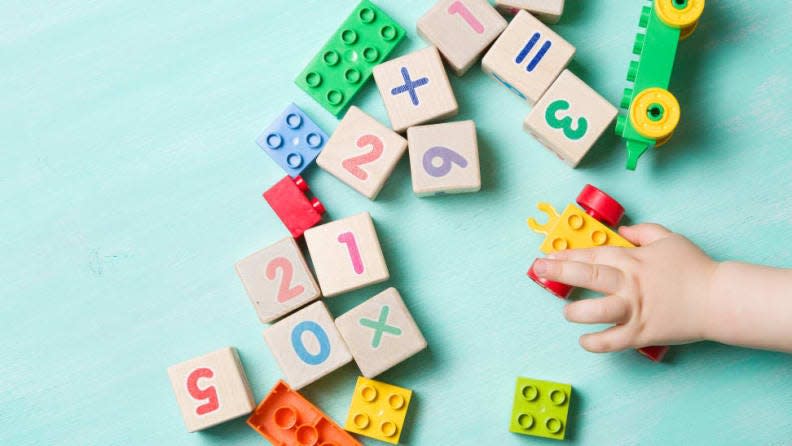Safety first when shopping for toys

Comedian Jeff Foxworthy makes a joke in his standup routine about the kinds of toys kids used to play with when he was young. Lawn darts and a wood-burning kit, just to name a couple.
While this 60-something-year-old man is possibly exaggerating for comedic effect, there is definite truth to the idea that parents and grandparents need to be aware of safety when it comes to picking out toys this Christmas.
Carley Barrett, a child life specialist in the emergency department at Intermountain St. George Regional Hospital spends her time working with children of all ages, helping them through a variety of traumatic situations. One of the best ways she’s found to connect with kids is by playing with them using age-appropriate, safe toys.
“Play is a child’s language,” Barrett said. “I try to normalize what they’re going through in the emergency department in order to help them cope.”
Depending on the age of the child, Barrett said she often takes a container of Play-Doh and talks with the child while their hands are busy creating something else. However, if the child is young, Barrett said you want to be cautious about introducing anything they might ingest.
“Just because things like Play-Doh may be non-toxic, doesn’t mean you want your kid to be eating it,” Barrett said. “If they’re little and they want to paint, but they are also at an age where they are mouthing things, you can make edible paint using yogurt and food coloring, or Kool-Aid powder and water.”
In addition to choking hazards, Barrett said it is important to think about what else a young child might do with little toys, like Lego or beads.
“Kids tend to find a spot for those kinds of toys in their nose, or in their ear,” Barrett said. “Even kids who are past the point of putting it in their mouth and choking, they might be curious and it ends up lodged someplace else.”
Some of the toys Barrett relies on in order to distract a child from a procedure, or to build rapport with them include “I Spy” books, interactive light-up toys, or even simple songs and games on a tablet.
“A good rule of thumb when selecting a safe toy is to pay attention to the age range listed on the label,” Barrett said.
Basic safety for toys such as bikes, scooters, ATVs and hoverboards include wearing a helmet.
“Especially at a young age, modeling is important, so parents need to wear helmets too and explain why they’re important,” Barrett said. “There are going to be accidents on these kinds of toys, but if we can protect their heads that is super helpful.”
Some other toy suggestions from Barrett include:
• 0-2 years — Children are in a sensory-motor stage so toys should be things they can touch and feel. Toys should be safe to be put in their mouths, such as safe-sized rattles. Anything with bright colors. Noise-making toys are also good at this stage.
• 1-2 years — is a fine motor stage. Shape sorters. Pop up toys that teach cause and effect.
• 2-4 years — Imaginary play is important here. Open-ended toys like animal figures, little dolls and cars, anything that allows the child to create their own story. Let the child take the lead when playing these toys with them. This is a good opportunity for children to express their thoughts through play.
• 5-7 years — Once they’re in the school-age years, their peers have a greater impact on the toys they choose. At this age, asking the child what they’re interested in is a great idea. Often this age enjoys arts and crafts, cooking supplies, age-appropriate video games; anything that gives the child a sense of accomplishment and mastery.
• Tween and teen phase — Children this age tend to know what they want. Outdoor and sporting equipment, books, music, clothes. It can be difficult to navigate this world of gift-giving without their input. However, oftentimes they want things that make them feel older, so gifts of self-care like bath bombs, headphones, face masks and other things help them feel more mature and gives a bit of responsibility.
As for electronics, including phones, tablets and video games, Barrett said this is the world kids are living in and it is up to the adults in their lives to teach them how to use these things safely.
“I think some parents are scared to let their child enter that world, but you just have to monitor it and have open conversations about those things,” she said. “Every child is different and every family is different, but teaching within certain guidelines is very helpful.”
With all gifts, maintaining a sense of mental safety is important as well, Barrett said. “We want them to create an identity for themselves in a safe way. Think about things that will build their self-esteem and empower them.”
This Live Well column represents collaboration between healthcare professionals from the medical staffs of our not-for-profit Intermountain Healthcare hospitals and The Spectrum & Daily News.
This article originally appeared on St. George Spectrum & Daily News: Live Well: Safety first when shopping for toys

